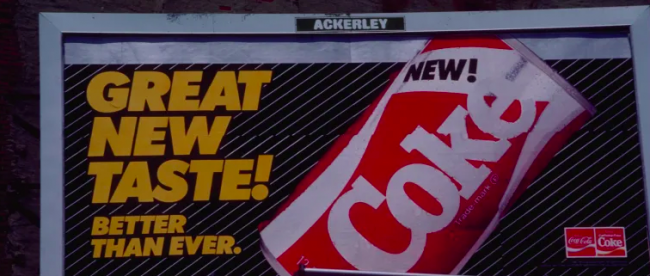The Weekender, July 12, 2019

1) “New Coke Didn’t Fail. It Was Murdered.” (Mother Jones, 17 minutes, July 2017). The phrase “act of Northern aggression” is in this piece. Central to it, in fact. And yet, it’s about soda. (There’s a Stranger Things reference below. If you haven’t seen the newest season — it’s great, by the way — it’ll ruin a minor joke, but isn’t going to spoil anything else.)
In late May, Coca-Cola announced it would produce 50,000 cans of New Coke as part of a promotional campaign linked to the third season of Netflix’s Stranger Things, which takes place in 1985, the same year the fizzy reboot made its short-lived debut. The new drink makes repeated cameos throughout the latest run, leading to a brief discussion of its qualities during an otherwise tense scene in episode 7.
“It’s delicious,” Lucas says, taking a long slurp. Five other kids stare at him in horror.
This is a fair representation of the prevailing literature on New Coke. For more than three decades, New Coke has been held up as the bad idea by which all other bad ideas are measured. Do a quick Google search for “the worst idea since New Coke” and you’ll find an encyclopedia of face-palms. Handmaid’s Tale–themed pinot noir. Mint-chocolate toothpaste. Indiana Jones and the Kingdom of the Crystal Skull. No one seems to dispute its shortcomings, least of all the people who ushered New Coke into the world. On the 10th anniversary of the drink’s introduction, the company’s CEO, Roberto Goizueta, told employees, sounding more than a bit like Churchill after Dunkirk, that what happened was “a blunder and a disaster, and it will forever be.” People speak with less moral clarity about war crimes.
The popular version goes like this: In the early 1980s, not content with producing the world’s most recognizable beverage, greedy executives tweaked the recipe for the first time in 94 years. They redesigned the can, launched a massive marketing blitz, and promised a better taste. But Americans wouldn’t stand for it. In the face of a nationwide backlash, the company brought back the old formula—now dubbed “Coke Classic”—after two months. The story of New Coke is eternal. It’s a parable of hubris.
It’s also a lie.
2) ‘The Tow Truck Turf War and the Driver Left for Dead” (Narratively, 9 minutes, July 2019). The subhead: “In Pittsburgh, the tow truck business is notoriously cutthroat. This winter, two rivals arrived at the same wreck and the feud crossed a line.”
3) The Now I Know Week in Review:
Monday: How a Texas Farm Helps Explore Space — I really liked the last line in this one.
Tuesday: Badge Boys, Badge Boys, Whatchu Gonna Do? — Meet the people who have fake police badges, legally (somewhat).
Wednesday: Why Do Bats Sleep Upside Down? — I incorrectly asserted that bats have bad eyesight in this one. They don’t, and I’ll fix that shortly (if you click, it’s probably still wrong).
Thursday: Gator Aid — Not gatorade.
WeekenderAdUnits
4) “Why We (Still) Can’t Live Without Rubber” (Nat Geo, 16 minutes, December 2015). The subhead: “As global car sales soar, the demand for tires is transforming Southeast Asia’s landscape. New plantations of rubber trees are lifting some out of poverty—but may also spark an ecological disaster.”
Because rubber is so common, so unobtrusive, so dull, it may not seem worth a second glance. This would be a mistake. Rubber has played a largely hidden role in global political and environmental history for more than 150 years. You say you want an industrial revolution? If so, you need three raw materials: iron, to make steel for machinery; fossil fuels, to power that machinery; and rubber, to connect and protect all the moving parts. Try running an automobile without a fan belt or a radiator hose; very bad things will happen within a minute. Want to send coolant around an engine using a rigid metal tube instead of a flexible rubber hose? Good luck keeping it from vibrating to pieces. Having enough steel and coal to make and drive industrial machinery means nothing if the engines fry because you can’t cool them.
5) “Why Americans Just Can’t Quit Their Microwaves” (The Atlantic, 7 minutes or about the time it takes to make two frozen meals, July 2019). As the article correctly states, “anyone who’s eaten microwaved food, whether it’s manufactured meals or leftover home-cooking, can probably imagine one reason it fell out of favor for most of a decade: It’s often not very good.” And yet, we still use the thing all the time.
Have a great weekend!
